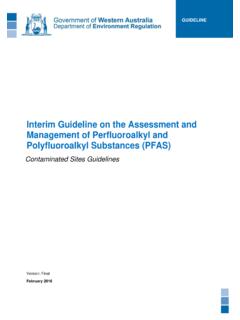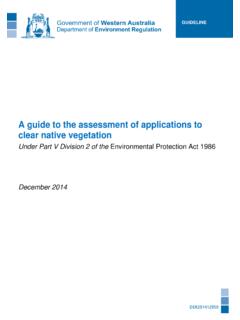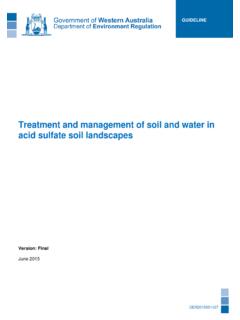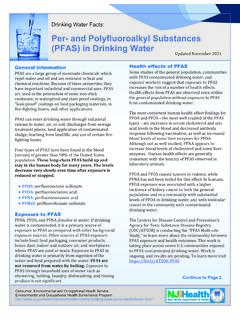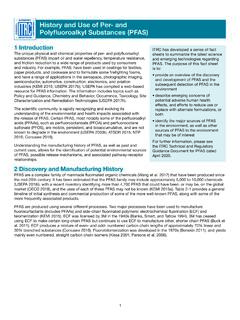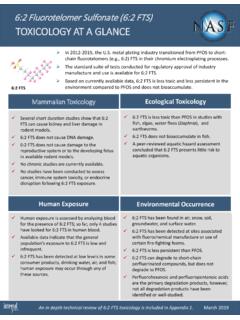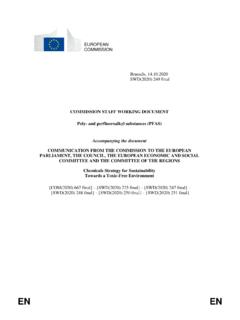Transcription of Controlled waste category list - der.wa.gov.au
1 Controlled waste category list The Controlled waste category list arranges the Controlled wastes listed in Schedule 1 of the Environmental Protection ( Controlled waste ) Regulations 2004 into 15 broad waste groups and assigns a waste code to each waste type within the group. The waste codes are used by industry and the Department of Water and Environmental Regulation for waste tracking and reporting purposes. category waste waste Type waste Examples Group Code A A100 waste resulting from waste from surface treatment of Plating & Heat the surface treatment metals and plastics Treatment of metals and plastics A110 waste from heat waste from heat treatment and treatment and tempering processes which use tempering processes cyanide which use cyanide A130 Inorganic cyanide Complex cyanides (inorganic).
2 Inorganic isocyanates Other cyanides (inorganic). B B100 Acidic solutions or Chromic acid Acids acids in solid form Glacial acetic acid Hydrochloric acid Hydrofluoric acid Mineral acids Mixed acids (inorganic). Nitric acid Phosphoric acid Pickle liquor Sulfuric acid Sulfuric/hydrochloric acid mixtures Other acids C C100 Basic (alkaline) Alkaline cleaners Bases solutions or bases Ammonia (alkalis) in solid form Ammonium hydroxide Calcium hydroxide Caustic soda Lime Potash Other alkaline waste Controlled waste category list (May 2018). 1. Department of Water and Environmental Regulation category waste waste Type waste Examples Group Code D D100 Metal carbonyls Iron pentacarbonyl Inorganic Nickel carbonyl Chemicals D110 Inorganic fluorine Inorganic fluoride wastes often compounds (excluding result from industrial processes calcium fluoride) such as steel manufacture, primary aluminium, copper and nickel production, phosphate fertiliser production and brick and ceramic manufacture Sodium fluoride D120 Mercury and mercury Mercury and mercury compounds compounds Mercury impregnated activated carbon Phenyl mercuric acid (PMA).
3 Phenyl mercuric chloride (PMC). Quicksilver D130 Arsenic and arsenic Arsenic and arsenic compounds compounds Arsenic Trioxide D140 Chromium compounds Hexavalent and trivalent chromium wastes D141 Tannery waste Tannery wastes such as leather dust, containing chromium ash, sludge and flours from tanneries who use chromium in their processes D150 Cadmium and Cadmium and cadmium compounds cadmium compounds D151 Used nickel cadmium No Controlled waste tracking form batteries currently required. D160 Beryllium and Beryllium and beryllium compounds beryllium compounds D170 Antimony and Antimony and antimony compounds antimony compounds D180 Thallium and thallium Thallium and thallium compounds compounds D190 Copper compounds Bluestone (copper sulphate).
4 Copper compounds (excluding copper fungicides). D200 Cobalt compounds Cobalt compounds Controlled waste category list (May 2018). 2. Department of Water and Environmental Regulation category waste waste Type waste Examples Group Code D D210 Nickel compounds Nickel compounds Inorganic Spent catalysts (nickel). Chemicals continued D211 Used nickel metal No Controlled waste tracking form hydride batteries currently required. D220 Lead and lead Grit blast waste compounds Lead wastes Used fire assay cupels D221 Used lead acid No Controlled waste tracking form batteries currently required. D230 Zinc compounds Zinc compounds D240 Selenium and Selenium and selenium compounds selenium compounds D250 Tellurium and Tellurium and tellurium compounds tellurium compounds D270 Vanadium compounds Spent catalysts Vanadium compounds D290 Barium and barium Barium and barium compounds compounds (excluding barium sulphate).
5 D300 Non toxic salts Aluminium dross, aluminium smelter waste Ammonium chloride Calcium chloride Non-metallic product Salt slag Sodium chloride D310 Boron compounds Borax Boron and boron compounds Boron trioxide D330 Inorganic sulfides Inorganic sulphur containing compounds D340 Perchlorates Perchlorates D350 Chlorates Magnesium chlorate Potassium chlorate Sodium chlorate D360 Phosphorus Ethyl phosphate compounds excluding Phosphorus and phosphorus mineral phosphates compounds (inorganic). Controlled waste category list (May 2018). 3. Department of Water and Environmental Regulation category waste waste Type waste Examples Group Code E E100 waste containing Barium peroxide Reactive peroxides excluding Sodium peroxide Chemicals hydrogen peroxide E120 waste of an explosive waste of an explosive nature not nature not subject to subject to other legislation other legislation E130 Highly reactive Highly reactive chemicals not chemicals not otherwise specified otherwise specified F F100 Aqueous-based Water based wastes from inks, Paints, wastes from dyes, pigments, paints, lacquers and Resins, Inks the production, varnish and Organic formulation and use of Sludges inks, dyes, pigments, paints.
6 Lacquers and varnish F110 Aqueous-based Water based wastes from resins, wastes from latex, plasticisers, glues and the production, adhesives formulation and use of resins, latex, plasticisers, glues and adhesives F120 Solvent based-wastes Solvent (hydrocarbon) based-wastes from the production, from inks, dyes, pigments, paints, formulation and use of lacquers and varnish inks, dyes, pigments, paints, lacquers and varnish F130 Solvent based wastes Solvent (hydrocarbon) based wastes from the production, from resins, latex, plasticisers, glues formulation and and adhesives use of resins, latex, plasticisers, glues and adhesives G G100 Ethers & highly Ethers Organic flammable waste aviation fuel (Av-Gas).
7 Solvents hydrocarbons waste petrol Controlled waste category list (May 2018). 4. Department of Water and Environmental Regulation category waste waste Type waste Examples Group Code G G110 Non-halogenated Acetone Organic organic solvents Benzene Solvents Ethanol continued Hexane Klenasol (non-chlorinated). Methanol Methyl ethyl ketone Methylated spirits Mineral turpentine Toluene waste jet fuel waste kerosene White spirit Xylene G130 Dry-cleaning Dry-cleaning wastes containing wastes containing perchloroethylene perchloroethylene G150 Halogenated organic Carbon tetrachloride solvents Genklene Not otherwise Methylene chloride (dichlormethane). specified paint stripper Tetrachloroethylene Trichloroethane Trichloroethylene Trinue G160 waste from Organic solvents and solvent production, use and residues not otherwise specified formulation of organic Solvent recovery residues solvents not otherwise specified H H100 waste from Arsenic based pesticides such as Pesticides the production, sheep dip, daconate, DMA (disodium formulation or use methylarsonate) and DSMA.
8 Of biocides and (disodium methyl arsenate). phytopharmaceuticals Biological pesticides Inorganic and organo-metallic pesticides including copper based fungicides Mixed pesticide residue Nitrogen containing pesticides including paraquat and trifluralin Sulfur containing pesticides Glyphosate Controlled waste category list (May 2018). 5. Department of Water and Environmental Regulation category waste waste Type waste Examples Group Code H H110 Organic phosphorous Organic phosphorus compounds Pesticides compounds Organo phosphorus pesticides continued H130 Organochlorine Chlordane pesticides DDT. Dieldrin Heptachlor Aldrin H170 waste wood- Copper-chrome-arsenic (CCA). preserving chemicals Creosote Organic wood preserving compounds Other inorganic wood preserving compounds J J100 waste mineral oils Mineral oils unfit for their original Oils unfit for their intended intended use (lubricating and purpose hydraulic).
9 Oils, hydrocarbons and emulsions Petroleum based grease such as axle grease Rags and absorbent material wet/. saturated with oil Transformer fluids (excluding PCB's). waste hydrocarbons which are not highly flammable, such as diesel waste mineral oil and coolant mixtures NOTE: Dried oily rags and absorbent materials (not containing free liquids). are generally suitable for disposal to putrescible landfill. If they are suitable for disposal at a Class I, II or III landfill they are not Controlled waste . J120 waste oil and water Cutting oils and soluble oils mixtures or emulsions, Hydrocarbon such as petrol or diesel and hydrocarbon and and water mixtures or emulsions water mixtures or emulsions waste oil and water mixtures or emulsions J130 Oil interceptor wastes Oil interceptor wastes Triple interceptor wastes J160 waste tarry residues Tars and tarry residues arising from refining, distillation or pyrolytic treatment Controlled waste category list (May 2018).
10 6. Department of Water and Environmental Regulation category waste waste Type waste Examples Group Code J J170 Used oil filters Used oil filters Oils NOTE: drained and/or mechanically continued crushed oil filters not containing free liquids are generally suitable for disposal to putrescible landfill. If they are suitable for disposal at a Class I, II or III landfill they are not Controlled waste . J180 Oil sludge Oil sludge from plate separators K K100 Animal effluent and Abattoir effluent Putrescible and residues Animal effluent and residues Organic Wastes Animal oils and derivatives Poultry and seafood processing waste Stock truck washes K110 waste from grease Grease interceptor waste from traps grease traps K130 Sewage waste Sewage waste from the reticulated from the reticulated sewerage system ( Water sewerage system Corporation).
